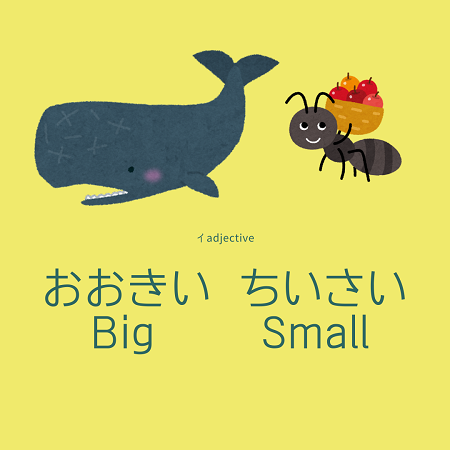There are two types of adjective in Japanese. These are イ adjectives and ナ adjectives.
In this article, I will teach you the differences between イ adjectives and ナ adjectives.
・What is a ナ adjective.
・Past tense of adjective.
・Negative form of adjective.
・The examples of adjective.
What is イ adjective

What is an adjective?
An adjective is a word that describes a noun.
A イ adjective is an adjective which ends in い when it describes noun.
For example, おおきい いぬ。(A big dog)
| にほんご (Japanese) | えいご (English) |
| おおきい | Big |
| ちいさい | Small |
| たかい | Tall(High) |
| ひくい | Low |
| ながい | Long |
| みじかい | Short |
| あたらしい | New |
| ふるい | Old |
| おもい | Heavy |
| かるい | Light |
| たかい | Expensive |
| やすい | Cheap |
| いい | Good |
| わるい | Bad |
Past tense of イ adjective
The past tense of a Japanese adjective is unique.
In English, b verb changes for past form like “He was small.”
You don’t say ”He smalled”, right?
However, in Japanese, the adjective itself changes.
For example, かれは ちいさかった。
How can we make it past tense?
You take い and add かった。
おおきい→おおき→おおきかった。
Let’s see examples.
| にほんご | えいご |
| おおきかった | Big |
| ちいさかった | Small |
| たかかった | Tall(High) |
| ひくかった | Low |
| ながかった | Long |
| みじかかった | Short |
| あたらしかった | New |
| ふるかった | Old |
| おもかった | Heavy |
| かるかった | Light |
| たかかった | Expensive |
| やすかった | Cheap |
| よかった | Good |
| わるかった | Bad |
When we speak, we say ”いい”, but when we conjugate, “いい” turns into “よい”.
Therefore, いい’s past tense is よかった。
negative form of イ adjective
Negative form is also unique.
In English, be verb changes.
However, in Japanese, the adjective itself changes as well as the past tense.
For instance, この レストランは やすくない。
How can we make it negative form?
You take い and add くない。
やすい→やす→やすくない。
Let’s see examples.
| にほんご | えいご |
| おおきくない | Not big |
| ちいさくない | Not small |
| たかくない | Not tall(High) |
| ひくくない | Not low |
| ながくない | Not long |
| みじかくない | Not short |
| あたらしくない | Not new |
| ふるくない | Not old |
| おもくない | Not heavy |
| かるくない | Not light |
| たかくない | Not expensive |
| やすくない | Not cheap |
| よくない | Not good |
| わるくない | Not bad |
When we speak, we say ”いい”, but when we conjugate, “いい” turns into “よい”.
Therefore, いい’s negative form is よくない。
What is ナ adjective

A ナ adjective is an adjective which ends in ナ when it describes noun.
For instance, ゆうめいな かしゅ。(A famous singer)
| にほんご | えいご |
| すき | Like |
| きらい | Not like |
| べんり | Convenient |
| ふべん | Inconvenient |
| ゆうめい | Famous |
| にんき | Popular |
| きれい | Clean |
| しずか | Quiet |
Please be careful of ”きらい” and “きれい”.
Many Japanese learners misunderstand these two.
They look イ adjectives, but they are actually ナ adjectives.
For example, きらいな やさい。(Vegetables which I don’t like.)
きれいな かわ。(Clean river.)
Past tense of ナ adjective
Past tense of ナ adjective is like past tense of noun.
We add だった。
(ex) あなたのことが すきだった。
Or でした is polite form.
(ex) あなたのことが すきでした。
| にほんご | えいご |
| すきだった すきでした | Like |
| きらいだった きらいでした | Not like |
| べんりだった べんりでした | Convenient |
| ふべんだった ふべんでした | Inconvenient |
| ゆうめいだった ゆうめいでした | Famous |
| にんきだった にんきでした | Popular |
| きれいだった きれいでした | Clean |
| しずかだった しずかでした | Quiet |
negative form of ナ adjective
We add じゃない.
(ex) この かわは きれいじゃない。
| にほんご | えいご |
| すきじゃない | Not like |
| きらいじゃない | I like it a little bit. |
| べんりじゃない | Not convenient |
| ふべんじゃない | Not inconvenient |
| ゆうめいじゃない | Not famous |
| にんきじゃない | Not popular |
| きれいじゃない | Not clean |
| しずかじゃない | Not quiet |
Please read this article too.
I explain what te form is.
Learn adjective and noun テ form -JLPT n5 grammar-
If you’d like to learn more Japanese, please feel free to contact me.
I teach Japanese in-person or online.
You can also learn Japanese on my Instagram page.

The free trial class online
We offer online classes and in person classes



